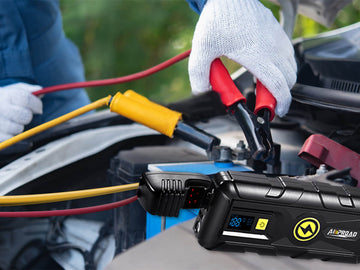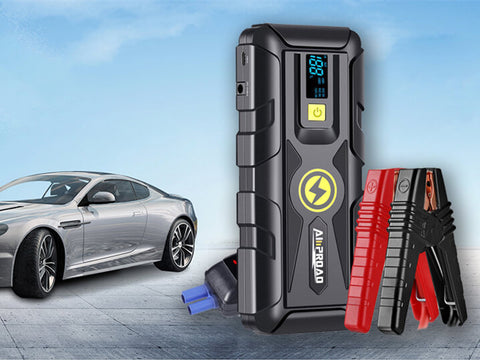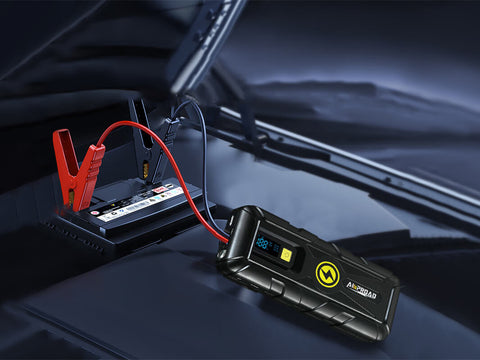
Welcome to the electrifying world of car troubles, where your vehicle decides to play the ultimate prank: refusing to start. In this automotive sitcom, you're the star, and the script involves jumper cables, a lithium jump starter, and a dash of comedic chaos. So buckle up, because we're about to embark on a laugh-out-loud journey through the highs and lows of jump-starting your car. Whether you're a seasoned comedian or just looking for a chuckle amid the sparks, we will have you revving your engines and rolling on the garage floor with laughter. Let's dive into the slapstick symphony of "Jump-Starting Your Day: A Comedy of Cables and Lithium Sparks!
Understanding Your Tools Portable Jump Starter and Jump Box
Before we embark on the jump-starting process, it's essential to acquaint ourselves with the tools that will come to our rescue. One such indispensable tool is the portable jump starter, commonly referred to as a jump box or car battery jump starter. This compact device is purpose-built to revive a dead battery, serving as a reliable solution in moments of vehicular distress.
Portable jump starter comes in various types, each designed to cater to specific needs and scenarios. These versatile devices typically consist of a battery enclosed in a durable casing, equipped with clamps and connectors. The clamps securely attach to the terminals of the dead battery, establishing a connection that allows the transfer of power from the jump starter to the vehicle's battery.
Best Portable Jump Starter
Understanding the different types of portable jump starters is crucial for selecting the one that best suits your requirements. Some models are equipped with additional features such as built-in air compressors or USB ports for charging electronic devices, adding to their utility beyond jump-starting capabilities.
The functionality of a portable jump starter is straightforward yet immensely effective. Once connected to the dead battery, the jump starter provides the necessary power to initiate the engine, enabling you to start your vehicle independently. This eliminates the need for a second vehicle and jumper cables, offering a convenient and self-reliant solution.

What makes a portable jump start particularly valuable is its compact size, making it easy to store in your vehicle. Its portability ensures that this essential tool is always within reach, ready to rescue you from unforeseen battery failures. This convenience is especially crucial in situations where professional assistance or access to another vehicle might be limited.
Navigating the saturated market of portable battery booster requires a discerning eye to identify the best among the options. In this essential guide, we delve into the key features that distinguish the top-tier portable jump starters.
Power capacity stands as a paramount factor, determining the jump starter's ability to effectively revive a dead battery. Optimal power ensures a swift and reliable engine start without the need for additional assistance. Safety mechanisms play an equally crucial role, with features like reverse polarity protection and short-circuit prevention enhancing user safety during operation.
Consider the versatility of the jumper box. Some models come equipped with additional features such as built-in air compressors, USB ports, or integrated flashlights, expanding their utility beyond jump-starting capabilities. Portability and ease of use are also vital; the best jump booster should be compact, lightweight, and user-friendly, ensuring it's readily available and accessible during emergencies.
By understanding and prioritizing these key features, you can make an informed choice when selecting the best portable jump starter. Whether you're a seasoned vehicle owner or a novice, having a reliable companion with these defining attributes ensures you're well-prepared to tackle unexpected battery issues with confidence.
Jump Starter Near Me
In the urgency of a dead battery, the question of "where to find a jump starter near me" becomes paramount. One solution that adds a layer of convenience to this predicament is partnering with a reliable portable jump starter supplier like Amproad. With Amproad, your go-to jump starter is not just a physical location but a compact and readily available device that can be conveniently stored in your garage, ensuring quick access when needed.
Beyond the traditional options of relying on a friend or a nearby service station, incorporating Amproad's portable car jump starter into your emergency toolkit brings unparalleled accessibility. This versatile device, with its compact design and user-friendly features, transforms any location into a potential jump starter point. The agility and convenience offered by Amproad ensure that you're never left stranded with a dead battery, providing a reliable solution that transcends the constraints of physical proximity.
Whether at home, on the road, or in remote locations, Amproad's portable car jump starter becomes your trusted companion in times of need. As you explore the best "jump starter near me" locations, consider the invaluable advantage of having a portable solution that transcends location limitations, offering swift and reliable assistance whenever your vehicle requires a jump start.
How to Jump Start Your Car with Jumper Cables?

Jump-starting your vehicle using jumper cables is a classic and reliable method, serving as a practical solution when faced with a dead battery. Let's delve into the step-by-step process, including how to use jump cables, ensuring a smooth and safe jump-start without risking damage to your vehicle's electrical system.
Step 1: Positioning the Vehicles
Begin by parking the functioning vehicle (the one with the charged battery) close enough to the vehicle with the dead battery. Ensure that the jumper cables can comfortably reach both batteries. It's essential to turn off the ignition in both vehicles before proceeding.
Step 2: Identifying the Battery Terminals
Take a moment to identify the positive (+) and negative (-) terminals on both batteries. These terminals are typically marked with red (positive) and black (negative) covers. Familiarizing yourself with these markings ensures a correct and safe connection.
Step 3: Connecting the Jumper Cables
Start by connecting one end of the red (positive) jumper cable to the positive terminal of the dead battery.
Next, attach the other end of the red jumper cable to the positive terminal of the functioning (charged) battery.
Moving on, connect one end of the black (negative) jumper cables near me to the negative terminal of the functioning battery.
Lastly, connect the other end of the black jumper cable to an unpainted metal surface on the vehicle with the dead battery. This serves as a ground and minimizes the risk of sparking near the battery.
Step 4: Starting the Vehicles
Start the engine of the functioning vehicle and let it run for a few minutes. This action helps charge the dead battery.
Attempt to start the engine of the vehicle with the dead noco boost. If it starts successfully, let both vehicles run for a few more minutes to ensure the dead battery gains sufficient charge.
Step 5: Disconnecting the Jumper Cables
In reverse order, carefully disconnect the jumper cables:
Start with the black (negative) cable from the previously dead vehicle.
Remove the black cable from the functioning vehicle's battery.
Proceed to remove the red (positive) cable from both batteries.
Following this sequence, which includes understanding how to use jump cables, minimizes the risk of sparks near the batteries. Remember to consult your vehicle's owner's manual for any specific instructions or precautions. Mastering the skill of jump-starting with jumper cables ensures a quick and efficient solution to revive your vehicle and get back on the road.
Why Transitioning to an Electric Vehicle with Home EV Charger Makes Sense
In the evolving landscape of transportation, transitioning to an electric vehicle (EV) with the convenience of a home EV charger is more than just a trend; it's a strategic move towards a sustainable and efficient future. Here are compelling reasons why making the shift to an electric vehicle, complemented by home EV charger technology, makes sense:
Environmental Stewardship:
Switching to an electric vehicle significantly reduces your carbon footprint. Unlike traditional internal combustion engines, electric vehicles produce zero tailpipe emissions, contributing to cleaner air and a healthier planet. By choosing an EV with a home EV charger, you not only enjoy the environmental benefits but also the convenience of charging at your residence.

Cost-Efficiency:
While the upfront cost of an electric vehicle might seem higher, the long-term savings are substantial. EVs generally have lower maintenance costs, as they have fewer moving parts and don't require frequent oil changes. Additionally, with government incentives and decreasing battery costs, the overall ownership expenses are becoming more competitive. Charging at home using a Level 2 EV charger further enhances cost-efficiency, allowing you to top up your vehicle conveniently overnight.
Energy Independence:
Electric vehicles with a home EV charger reduce dependency on traditional fossil fuels, promoting energy independence. With the growing emphasis on renewable energy sources, EVs align with a future where power comes from cleaner and more sustainable options. This shift contributes to a diversified energy portfolio and less reliance on non-renewable resources, especially when you charge your Tesla at home using the Tesla Mobile Connector Adapter.
Technological Advancements:
The rapid advancements in EV technology have addressed concerns related to driving range and charging infrastructure. Modern electric vehicles boast impressive ranges, and the availability of home EV chargers makes recharging a seamless part of your daily routine. Tesla owners can further enhance their charging experience by utilizing the Tesla Mobile Connector Adapter for versatile charging options.
Convenient Home Charging Stations:
Investing in a home EV charger provides the convenience of having your charging station right at home. No more detours to public charging stations; simply plug in your electric vehicle at the end of the day, ensuring it's always ready for your next journey. This level of convenience is especially beneficial when utilizing a Level 2 EV charger, offering faster charging times compared to standard outlets.
So, it makes sense that transitioning to an electric vehicle with the added convenience of an EV home charger aligns with the broader goals of environmental sustainability, cost-efficiency, and technological advancements. It's not just a shift in vehicles; it's a transition towards a cleaner, smarter, and more responsible way of driving, ensuring a brighter and greener future for generations to come.


